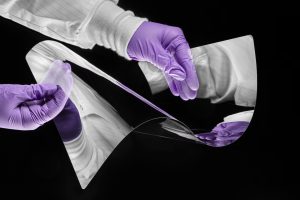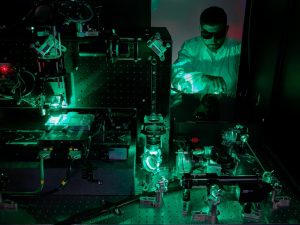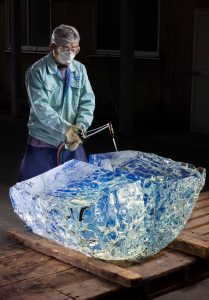*The glass industry in Mexico has a professional business platform, designed for the exchange of information, the presentation of products, services and technological innovation, including training sessions and lectures on current trends within the sector. Glasstech Mexico / Doors & Windows, will be held from July 9 to 11, 2024 at Expo Guadalajara. Please register as a trade visitor here: https://shorturl.at/J21b3
A glass revolution is underway. Spoiler alert: it bends and bounces
Humans have been making glass for 4,000 years. But now, scientists are developing techniques that will impact everything from medicine to the way we see the universe.
(via Jay Bennett – NatGeo)
On a brisk March afternoon, Kazuhiko Akiba and a colleague stood in the courtyard of the Chiba Kogaku glass factory in Japan, ready to unveil their latest creation. A forklift wheeled out a large clay pot about the size of a hot tub and set it down before them. Dressed in the company’s sky-blue uniforms, the men put on safety glasses and gloves. Then each grabbed a sledgehammer, hefted it overhead, and slammed it against the outer edges of the pot. Their blows landed with solid thwacks, chipping away heavy ceramic to reveal the prized contents beneath: a hard, luminous substance that caught the afternoon sun. It glowed in pale cerulean hues, like Arctic ice.
Akiba, the factory director, stepped back in admiration. “Kirei,” he said. Beautiful. This was the latest batch of what’s known as E6, some of the world’s purest optical glass.
Located east of Tokyo and surrounded by peanut farms, Chiba Kogaku has been making glass in handmade clay pots for more than 50 years. The technique dates to the early 1800s, when Swiss lens maker Pierre-Louis Guinand pioneered the method of using ceramic stirrers to mix molten glass. That process yielded a product devoid of bubbles and contaminants and ideal for optics. In 1965 a Japanese firm, Ohara Glass, refined the process with its own admixture to develop E6, a so-called low-expansion glass that’s now made for Ohara only at Chiba Kogaku.



A single pot, holding about 200 gallons, takes roughly four months to create. First, the clay vessel must be hand-sculpted. Then workers pour in a mix of silica, boron oxide, aluminum oxide, and other materials and heat the pot to 2700 degrees Fahrenheit. As it melts, the molten glass must be stirred periodically for more than two days before the pot is placed in a temperature-controlled chamber to cool for two weeks.
Breaking the clay pot removes the outermost layer of glass, leaving behind a pure substance that can be remelted and formed into precise shapes that remain constant even in extreme temperatures—hence, the “low expansion” part of its name. This stability is crucial when you’re trying to build glass mirrors for large telescopes.
The market for such wildly expensive instruments, the kind that let astronomers peer into the deep recesses of space, is limited. So limited that all the E6 produced in the past 42 years has been delivered to a single buyer. A huge amount—134 tons—is for a project that, if successful, will change the way we think about the universe.
E6 is just one example of how glass is being reinvented to explore a range of frontiers. In fact, glass has seen more technological and industrial developments in the past half century than in the previous millennium, prompting the UN in 2022 to recognize glass as the 100 percent recyclable building block most likely to help countries reach sustainable-development goals by 2030.
Simply put, we’ve entered a new glass age, one in which scientists will use this ancient material to radically improve our lives.
At the factory, Akiba warns me not to touch the newly exposed glass because its surface is covered with tiny shards. As the sun sets, the massive chunk continues to change hues, shimmering with hints of topaz, then aquamarine and silver. Transfixed, I watch the colors transform, the otherworldly material sparkling as though golden stars were suspended within.
There’s a popular Internet meme showing the moment toddlers are fitted with their first pair of eyeglasses. In each video, a child goes from bawling or confused to looking stunned and wide-eyed as he or she for the first time can clearly see his or her parents. That’s how eight-year-old me felt as I walked through a Costco wearing my first pair of glasses. I gawked in amazement at the sharply defined store aisles, all thanks to a technology developed more than 700 years ago and used by billions of people since.
Getting eyeglasses has become such a mundane part of modern life that we’ve practically forgotten the impact the invention of optical lenses has had on civilization. But that’s true of most of the ways that glass has profoundly changed the human experience. Try imagining life without bottles and baking dishes, mirrors and windows, light bulbs and televisions. If you’re reading this story on your mobile phone, you tapped a glass touch screen and these words popped into view via data that traveled on glass fiber-optic cables.
Humans have been progressively weaving this material ever deeper into their lives since they discovered how to produce it about 4,500 years ago. While it’s unknown exactly where the first glass was created, some of the oldest glass beads and other trinkets have turned up in Mesopotamia. Historians theorize that the first glass may have been the accidental by-product of ceramic or metal production. Whatever the case, people quickly figured out how to manipulate the process, as evidenced by a Babylonian clay tablet found in present-day Iraq, which records in cuneiform one of the earliest known glass recipes. It even notes how to tint it red.
Whether ancient or modern, nearly all glass contains the same basic formula: a mixture of silica (the primary ingredient), soda ash (to lower the melting point), and limestone (to stabilize it). But part of what makes glass special is a sort of accident of nature—the result of a process interrupted. When the main ingredients are heated to about 1800 degrees Fahrenheit and then cooled, the atoms in the mixture naturally want to form a structure like the crystalline matrix in a sheet of ice or a diamond. Instead, the atoms become trapped in a random configuration yielding something between a solid and a liquid, which can be reshaped before it cools and hardens. The result is called an amorphous solid.
This disordered molecular structure is what gives glass its superpower: a chameleonlike adaptability. Since there’s no need for its atoms to lock into a specific pattern, at elevated temperatures its structure can incorporate a wide range of chemical compounds. Such additions can provide color, flexibility, greater heat resistance, and increased strength, among other desired traits.
“The compositions of glass are infinite, and you can continuously change their properties,” says Alicia Durán, a glass professor at the Spanish Research Council and past president of the International Commission on Glass, which has worked with the UN to champion the new glass age (a term Durán often uses).
But she loves glass for another reason: “The main quality of glass is that it can be produced, reproduced, born and reborn—really in the same or other applications—forever. And so this is the basis for sustainability,” she says.
For scientists, that creates an opportunity for endless experimentation, and the centuries have shown how one advancement can continue to inspire another. Case in point: On a recent day, I visited the “test kitchen” at the Engineering and Materials Processing lab at Corning, the multinational glass and ceramics company located in upstate New York. There, technicians clad in heavily insulated, heat-reflecting suits and face shields used steel pokers and tongs to remove a white-hot cup of molten glass from an industrial furnace, carefully pouring one of the thousands of new formulas they regularly experiment with here. (Claiming trade secrets, they wouldn’t tell me anything about the one I saw them working on.)
Famously, Corning teamed with Thomas Edison to improve his light bulb in 1879. Since then, the company has debuted a parade of glass firsts, from durable Pyrex labware (used to produce penicillin and distribute the first polio vaccines) to early fiber-optic lines (the backbone of the information superhighway) and ultradurable Gorilla Glass (which—usually—keeps your phone screen from shattering).
While much of what’s in development at Corning remains secret, plenty of researchers are openly sharing their next targets. Take bioactive glass: In 1969 a University of Florida professor discovered that if you swap out some silica for calcium, you’re able to create fine glass pellets or powders that bond with shattered bones, speeding up healing.
That discovery has led to bioglass being reformulated as a potential treatment for infections in bones and soft tissue wounds, says Julian Jones, a materials scientist at Imperial College London who has been studying bioglass for 25 years. If effective, the idea could solve one of the most vexing issues facing medicine, as growing numbers of pathogens evolve to become resistant to antibiotics. Jones pioneered a “bouncy bioglass,” an experimental 3D-printed, rubbery, glass polymer, designed to regrow cartilage. “For older patients with arthritis,” he says, “this is kind of the holy grail of cartilage regeneration.”
For Himanshu Jain, who directs the Institute for Functional Materials and Devices at Lehigh University, glass will play a crucial role in renewable energy. It’s already a key material in solar panels and fiberglass blades for wind turbines. Why not, Jain asks, create windows that convert solar energy into electricity? He also foresees other glass breakthroughs: glass fertilizer pellets that release nutrients and glass computer chips able to process information via light instead of electrical signals.
One of the more controversial uses for glass technology comes from the Pacific Northwest National Laboratory in Washington State, where scientists say they’ve improved upon a decades-old method to immobilize radioactive material. The team’s goal is to devise a way to contain the 56 million gallons of stored nuclear waste that still exists at the Hanford Site, a plant that processed plutonium for the Manhattan Project and during the Cold War. “Our waste has virtually the whole periodic table of elements in it, and that has atoms of multiple different sizes that like to bond with different angles,” says John Vienna, the scientist who leads the research.
To solve this problem, the team came up with many kinds of glass to incorporate the different types of radioactive pollutants. The vitrified waste will outlast the radioactive half-life of most of the toxic material—although much debate continues over where to safely store it. After Vienna and I spoke, the team overseeing the vitrification process agreed to mail me a small chunk of test glass—made from nonradioactive material—to show me what the storable waste would look like.
When the package arrived, I pulled out a smoky gray lump, about the size of a deck of cards. It wasn’t beautiful like the chunk of E6, but the thought it could help resolve a long-standing environmental disaster gave it a different allure.


